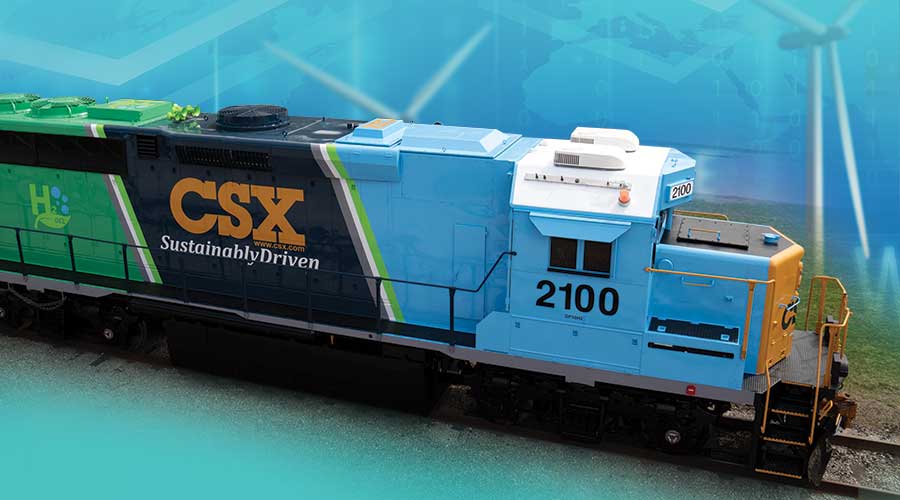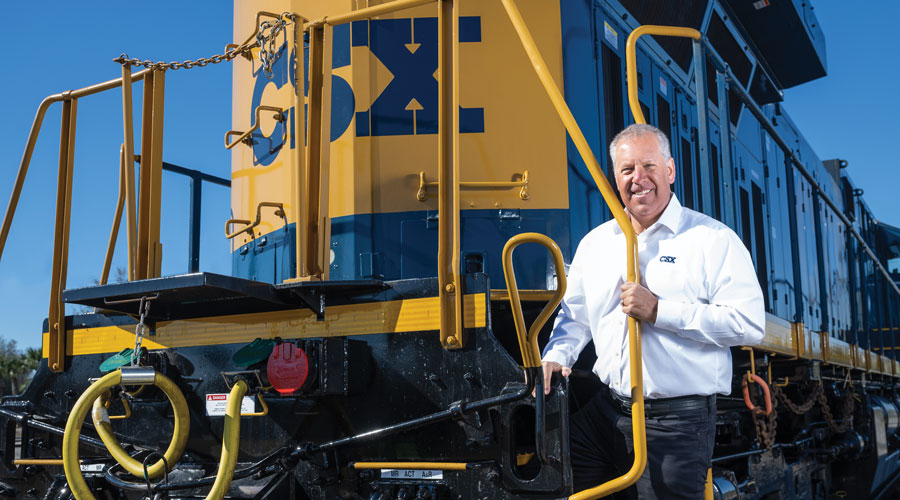Stay updated on news, articles and information for the rail industry
November 2016
Rail News: CSX Transportation
The 'CSX of Tomorrow' will dawn if the railroad can adopt a more intermodal-driven, less coal–centric operating strategy
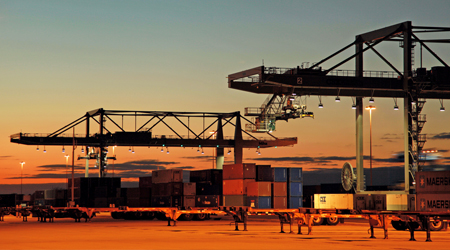
By Jeff Stagl, Managing Editor
To say sagging coal volumes have been a drag on CSX’s finances the past five years is an understatement. Coal revenue losses that have been mounting since 2011 are expected to reach a total of $2 billion by 2016’s end.
The Class I’s coal fortunes aren’t expected to turn anytime soon, either. Low natural gas prices figure to keep compelling domestic utilities to favor that power-plant fuel source for the foreseeable future and tectonic shifts in the global coal market are forecast to keep abating U.S. exports. So, a change in strategic direction is necessary to deal with coal’s steep fall from its longtime perch as the railroad’s top revenue producer.
Last year, the senior executive team met to develop a strategy framework that could address the changing customer base and shifting business portfolio. Ultimately, the team considered two options: continue to chase ways to help overcome the coal losses in the short term or develop a plan to change the structure and operation of the coal-dominant railroad for the long term. They opted for the latter.
A 40-member cross-functional group that included leaders from each department then helped flesh out the idea and shape specific supporting initiatives, and CSX’s board reviewed and approved the chosen strategy in early 2016. Now, if it ushers the Class I into a new era as hoped, the “CSX of Tomorrow” will dawn in the not-too-distant future.
Formally launched in late April, the CSX of Tomorrow (CoT) strategy calls for the company to:
• realign its network to de-emphasize coal traffic and optimize the volume-growth potential of the more promising intermodal sector and solid merchandise segment;
• deploy more high-tech equipment and information systems to forge a highly automated railroad that can support safety, service-performance and efficiency efforts;
• pursue service excellence to help prompt volume growth and better meet customers’ needs; and
• develop a workforce of the future with the right tools and skills to drive productivity and innovation.
Expected to take a number of years to implement, the strategy will help spur volume growth and increase profitability in the intermodal and merchandise franchises, and yet preserve the business value of coal as it becomes a smaller part of the company’s portfolio, says CSX Chairman and Chief Executive Officer Michael Ward.
“We’ve got to adapt; the world has changed. Coal has gone from one-third of our annual revenue to about 15 percent,” he says. “We have been a more cyclical company, one that was a slave to the vagaries of the general economy. Now, we can be more nimble and flexible.”
CSX will benefit by controlling the things it can control: service, safety and productivity, says Ward. In addition, the strategy can help the company attain its long-term goal of a mid-60s operating ratio.
CSX plans to carry out the CoT in part by operating two networks: a primary one accommodating longer and heavier trains along the “Iron Triangle” mainlines between Chicago, New York City and Jacksonville, Fla.; and a local one comprising other lines and territories that don’t require the same train speeds and resource intensity. Each network will essentially have the same route mileage, and the local network would retain the same level of safety and customer service as the primary one.
CSX also aims to extend sidings or build new ones to accommodate longer trains; triple the amount spent each year on technology adoptions; and provide better quality-of-life benefits and more modern equipment to hone a stronger workforce.
Operational performance a prime component
Service execution is the most critical aspect of the CoT, says Ward. To win over and best serve shippers of truck-competitive freight, CSX needs to align operating capabilities to customers’ expectations and provide consistently higher levels of reliability.
“If we want to grow our other businesses, the service has to be there,” says Ward.
He believes the CoT initiative aligns well with the company’s vision to be the safest, most progressive North American railroad, one that relentlessly pursues customer and employee excellence. It lines up with CSX’s core values, too, says Ward. That means continually striving to be fact-based, ensuring people make the difference, stressing safety as a way of life and getting the right results the right way.
“It’s how we behave and who we are. It still fits,” says Ward. “The biggest difference [with the CoT] is being more intentional in deploying technology.”
CSX strategists performed a lot of modeling exercises to ensure the strategy could be carried out, and the team plans to tweak and refine it as CoT implementation continues.
“The way we see it is: OK, we have a path now, and we see where we’re going,” says Ward.
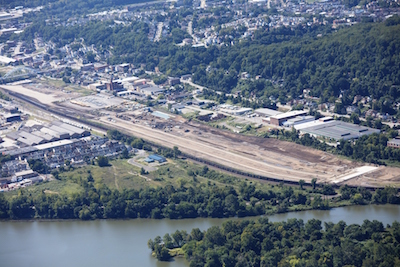 A new terminal under construction in Pittsburgh, which is slated to open next year, figures to help boost intermodal business. CSX
A new terminal under construction in Pittsburgh, which is slated to open next year, figures to help boost intermodal business. CSXBut there will be some bumps along that path. For example, to become a more efficient and productive CoT, there will be hundreds of fewer jobs at the company. Meetings have been held with rail labor unions about the job reductions, which mostly will be addressed through attrition, says Ward.
“We’re not being secretive about it. We will have less jobs available,” he says.
In addition, softness in several commodities doesn’t bode well for efforts to boost merchandise traffic in the near term. Stifel Financial Corp. analyst John Larkin, who covers CSX, questions whether the Class I can generate enough incremental volume on the primary lines connecting Chicago, New York City and Atlanta in light of ongoing bulk commodity challenges. Yet, he believes the railroad’s intermodal prospects are promising.
“Fortunately, the company’s hub-based intermodal strategy is the only one that provides a path to serving lighter density origin-destination pairs,” said Larkin in an email. “That approach provides CSX with a myriad of additional lane-based opportunities to handle the less service-sensitive international and domestic intermodal traffic.”
Overall, the CoT strategy makes sense and is something “the troops can rally around,” he said.
“I give the management team credit for outlining a sensible, relatively low-risk game plan that should drive incremental shareholder value in the post coal-intensive world,” said Larkin.
Another CSX observer agrees the tactics of CoT are sound, particularly in terms of adopting technologies and driving productivity, such as by better managing such key assets as locomotives and rail cars.
“One metric I see as meaningful is asset turnover. I think we will see more continue to be done by [CSX] with turning assets more efficiently,” says Benjamin Hartford, a Robert W. Baird & Co. Inc. analyst.
However, the relative strength of the U.S. dollar — which is weakening industrial production and rail volumes — poses a broader macro-environment challenge to the CoT initiative, he believes. CSX’s intermodal volumes likely won’t reach the high single-digit percentage growth witnessed in the past eight to 10 years, although there still are opportunities to take market share from trucks in the East as truckers’ operating costs continue to rise, Hartford says.
Trending in the right direction
The railroad’s domestic intermodal volume has increased about 7 percent each year for the past 10 years, and secular trends bode well for growth in the long term, says CSX Executive Vice President and Chief Sales and Marketing Officer Fredrik Eliasson. Strategic network investments — such as new and expanded intermodal terminals — have helped drive and support highway-to-rail conversions.
CSX’s network reaches two-thirds of the U.S population and 60 percent of the nation’s manufacturing capacity, and there are 9 million loads in the East that travel more than 550 miles on highways that could be diverted to rail, says Eliasson.
“We just need a fraction of that to keep growing at [the same] pace,” he says.
It helps that the new primary and local networks reach a lot of busy and productive points in the East.
“We are connecting more dots than anyone else,” says Eliasson.
And those intermodal connections figure to gain an assist over the next few years from some major capacity-boosting projects. A new 70-acre terminal in Pittsburgh pegged to handle 50,000 containers annually is slated to open in 2017; a Carolina Connector terminal the railroad is building in conjunction with the state of North Carolina in Rocky Mount is projected to process more than 260,000 containers annually after it opens in 2020; and work to overhaul the more than century-old Virginia Avenue Tunnel in Washington, D.C., is expected to produce a new tunnel by year’s end and a second new tunnel in 2018.
After the tunnel project is completed, CSX’s network will be 95 percent instead of 90 percent double-stack capable, says Eliasson. The last major piece to the full-capability puzzle is clearing the more than 120-year-old Howard Street Tunnel in Baltimore for double-stack trains.
Earlier this year, the U.S. Department of Transportation denied a joint CSX/state of Maryland application for federal funds from the Fostering Advancements in Shipping and Transportation for the Long-term Achievement of National Efficiencies (FASTLANE) Program for the $425 million project. But last month, Ward and Maryland Gov. Larry Hogan reconfirmed their commitment to finance the tunnel work and announced the state’s intention to reapply for a FASTLANE grant in the program’s next funding round. CSX and the state have agreed to jointly cover $270 million of the project’s cost.
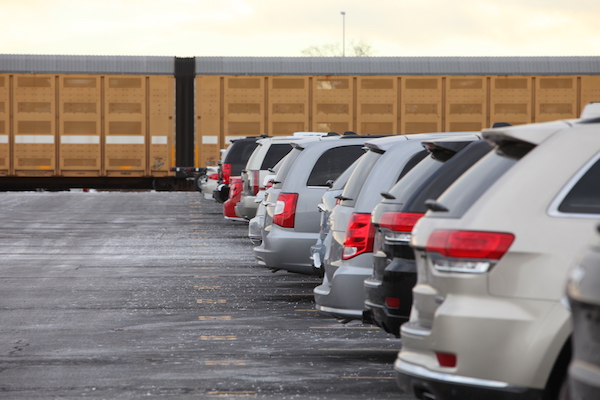 Automotive loads should be a plus for merchandise volume next year. That traffic sector is expected to be favorable in 2017 after a record-setting 2016. CSX
Automotive loads should be a plus for merchandise volume next year. That traffic sector is expected to be favorable in 2017 after a record-setting 2016. CSXIn terms of merchandise traffic, Eliasson is optimistic about volume-boosting prospects in the agricultural products, core chemicals and lumber/forest products traffic groups due to a record grain harvest, non-energy market growth and a strong housing sector. He also expects automotive traffic to grow slightly in 2017 after a record-setting 2016.
And even though the CoT initiative de-emphasizes CSX’s coal franchise, there’s still hope for a traffic turnaround in that sector, says Eliasson.
“We can’t plan for coal to be there, but we’re not turning our back on coal. We want more coal,” he says.
It all comes down to execution
But to capture more traffic opportunities while adopting the CoT, service execution — and convincing shippers that the performance excellence push isn’t just “lip service” — are key, says Eliasson. Execution has four main components: Do what you say you’ll do; be proactive when something happens; communicate with the customer; and ensure every interaction with a customer is a positive one.
“Don’t wait for a customer to tell us there’s a problem or service issue. And show them that we care,” says Eliasson. “Service excellence is good for price, good for volume growth and good for productivity.”
A reshaped “Network of Tomorrow” is good for those things, as well. The primary and local networks to come will optimize infrastructure and equipment to ensure the railroad is using them to its best advantage, said CSX EVP and Chief Operating Officer Cindy Sanborn in a CoT magazine distributed to employees in late summer.
The company can allocate resources and route trains in ways that boost capacity, improve service and cut costs, she said.
“By investing more capital on the primary network, we can shift additional long-haul traffic into those corridors, which support longer trains and higher speeds. You might think of it as the railroad equivalent of superhighways,” said Sanborn. “In general, the local routes will be classified for lower speeds, and trains that benefit from higher velocity will be directed over the primary network.”
CSX already has begun to implement the Network of Tomorrow by addressing local lines between Waycross, Ga., and Montgomery, Ala. In addition, various trains currently moving on local lines have been identified as candidates to transition to primary corridors and service design changes are underway to support new traffic flows, said Sanborn.
A lengthy proposition
CSX also has started the longer-siding push along its line from Nashville to Cincinnati. Traffic on the corridor had been restricted by sidings up to 6,500 feet long, and the longer sidings will stretch to about 12,000 feet.
Over the next three to five years, dozens of other sidings now 6,000 to 8,000 feet long will be extended to the 12,000- to 14,000-foot range, says CSX EVP and Chief Financial Officer Frank Lonegro.
Efforts to lengthen trains to support higher productivity already have paid off. Train lengths across all commodities have increased 10 percent this year and about 20 percent since 2014, with some trains stretching to as many as 200 cars.
Longer sidings and longer trains also are helping the railroad reap efficiency savings in 2016. This year’s savings now are projected to reach about $400 million, exceeding a $200 million goal set in January and a mid-year forecast of between $300 million and $350 million. Costs are being trimmed in all departments, says Lonegro.
“We have dug really deep this year. Every dollar is being challenged now,” he says.
Another operational element that’s helping CSX and its CoT strategy: a variable scheduling plan enacted last year. Origin-destination pairs are matched at each terminal according to a 6-day/28-hour operating schedule instead of a prior 7-day/24-hour schedule. The 7/24 schedule isn’t optimal because each terminal’s “clock” is different every day, says Lonegro.
“It has had a galvanizing effect in the company,” he says. “We took a ‘risk to fail,’ which hadn’t been done before [with scheduling]. Our risk tolerances have expanded a bit — it’s all about risk and reward.”
Divvy up capex differently
CSX is taking the same approach with capital expenditures, the risk being a lower budget than in years past, but with the reward of more dollars for strategic growth initiatives. Although 2016’s all-in capex budget will total about $2.7 billion — in part because CSX plans to pay off a locomotive order that had a final payment scheduled in 2017 — future budgets will return to a range of 16 percent to 17 percent of annual revenue, says Lonegro. Using the $11.8 billion CSX generated in total revenue last year, that would mean a capex budget of about $2 billion.
In addition, the railroad no longer will maintain its usual split of capex dollars: 85 percent for infrastructure maintenance and asset allocations, and 15 percent for strategic growth initiatives, such as terminal expansions and siding extensions. The new split will be 75 percent/25 percent, says Lonegro.
“We will have a good balance with the maintenance aspect of capex and the growth aspect, for technology and other CSX of Tomorrow things,” he says. “We will take a disciplined approach to capital, and it won’t impact safety and the reliability of the network.”
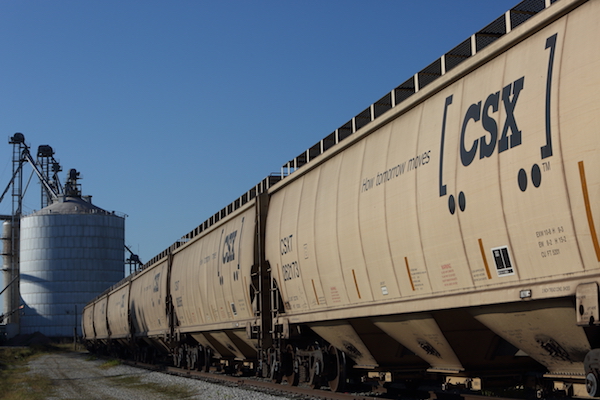 A strong grain harvest is a good omen for CSX's agricultural products traffic. CSX
A strong grain harvest is a good omen for CSX's agricultural products traffic. CSXCSX also plans to double or triple the $100 million typically spent annually on technology, such as newly developed equipment and software, says Lonegro.
That’s good news for the company’s CoT endeavors and for Kathleen Brandt, who in May became the Class I’s first-ever chief information officer and joined the senior executive team. Previously, IT and other technological responsibilities were assigned to the president of CSX’s IT subsidiary.
It’ll take an influx of dollars for CSX to reach the highly automated railroad stage, senior execs believe.
“When thinking about a highly automated railroad, it’s how you use analytics in new ways and how you automate and how you address mobility, all in a timely fashion,” says Brandt, who headed the IT subsidiary before becoming SVP and CIO.
In terms of analytics, CSX seeks to use the vast amount of data collected by numerous digitized assets in a “Big Data” way to gain more insights, she says. For example, CSX is working with Mtell — which uses machine learning technologies in conjunction with industrial assets to provide analytic solutions — to analyze locomotive oil samples to help determine if an engine problem might be developing.
Going mobile
As for mobility, the Class I is rolling out a mobile rail tool for train crews. The tablets will enable crew members to receive real-time inventory adjustments from a customer or view a map of a customer’s territory, as well as send notifications — such as an estimated time of arrival — to a customer in real time.
“We think of it as an extension of customers, to see things as they see them,” says Brandt.
Other technological pursuits include:
• continuing to roll out an “X-Gate” inspection camera system/mobile processing app at intermodal terminals to reduce the time draymen spend on processing paperwork and inbound/ outbound inspections;
• using unmanned aerial vehicles, or drones, with video cameras to inventory critical assets, and tethered drones with infrared systems to monitor yards at night;
• deploying two tampers “platooned” together via software and operated by one person to tamp track more efficiently and safely; and
• exploring the use of fiber optics along rights of way to determine the sound signatures of a flat wheel or trespasser.
“The ultimate goal is asset health,” says Brandt.
Another goal: developing a “Team of Tomorrow” for the CoT. Such a workforce would be more responsive, flexible and innovative, both in work processes and attitude toward their jobs, said CSX SVP and Chief Administrative Officer Cressie Brown in the employee CoT magazine. The Class I seeks to establish a talent pipeline to retain the experienced and skilled employees who contribute at a high level, as well as recruit “the best and brightest” new workers, said Brown, who also joined the senior exec team in May.
Beneficial benefits
In terms of recruiting, some new quality-of-life benefits are expected to provide a significant boost. New management employees now receive three weeks of paid vacation instead of two; maternity leave was increased from six weeks to 10 weeks; non-birth parents now receive two weeks of paid parental leave for an adoption or foster parenting; and workers can take up to two weeks off to care for an adult parent or a loved one with special needs. The railroad didn’t previously offer any time off for such care.
The railroad will need a lot of help from top to bottom to become the CoT. And a lot of time.
Even though the company’s transformation is only in the infant stage, third-quarter financial results show there’s work yet to be done. On a year-over-year basis, quarterly intermodal revenue declined 6 percent to $425 million and merchandise revenue decreased 4 percent to $1.7 billion, while coal revenue fell 20 percent to $467 million.
CSX is using 2016 as a base year for the CoT and plans to provide more details about the strategy in 2017, says Ward. In the meantime, some of what’s being done to transform the company is new, some is evolutionary and some is an acceleration of things already underway, he says.
“I might use the word ‘radical’ to describe some of the changes,” says Ward.
CSXers have always been good strategic thinkers, but this is the first time a strategy of this magnitude is funded and primed for implementation, says Lonegro. Now, it’s up to everyone to marshal the company’s strengths and execute that strategy.
“This is a plan that we all agree on, and we understand the tradeoffs we need to make,” says Lonegro. “It all resonates — it’s simple and understandable.”
Keywords
Browse articles on CSX intermodal Virginia Avenue Tunnel Network of Tomorrow Team of TomorrowContact Progressive Railroading editorial staff.


 2025 MOW Spending Report: Passenger-rail programs
2025 MOW Spending Report: Passenger-rail programs
 Gardner steps down as Amtrak CEO
Gardner steps down as Amtrak CEO
 Guest comment: Oliver Wyman’s David Hunt
Guest comment: Oliver Wyman’s David Hunt
 Women of Influence in Rail eBook
Women of Influence in Rail eBook
 railPrime
railPrime




